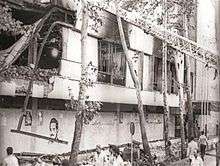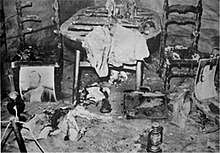1981 Iranian Prime Minister's office bombing
| 1981 Iranian Prime Minister's office bombing | |
|---|---|
| Part of Terrorism in Iran | |
 The Iranian PM building after the explosion | |
| Location | Tehran, Iran |
| Date |
30 August 1981 15,[1] 14:45[2] (+3:30) |
| Target | Iranian officials |
Attack type | Bombing |
| Deaths | 8[3] |
Non-fatal injuries | 23[3] |
| Assailants | Masoud Keshmiri (agent of MEK) |
The office of Mohammad Javad Bahonar, Prime Minister of Iran, was bombed on 30 August 1981 by the People's Mujahedin of Iran (MEK), killing Bahonar, President Mohammad Ali Rajai, and six other Iranian government officials.[4][5] The briefcase bombing came two months after the Hafte Tir bombing, which killed over seventy senior Iranian officials, including Chief Justice Mohammad Beheshti, then Iran's second-highest official.
According to Western observers, the MEK was most likely responsible for the explosion, due to their "arsenal and experience in terror tactics."[6] It was later proved that the attack was carried out by MEK agent Masoud Keshmiri, secretary of Bahonar's office and of the Supreme National Security Council,[7] who used a fake passport to escape Iran after the attack.
Afterwards, the interim presidential council announced five national days of mourning, and Iran's Parliament selected Ayatollah Mahdavi Kani as the next prime minister.
Background
The MEK, originally founded in 1965 by leftist Iranian students who opposed Shah Pahlavi, targeted Khomeini's theocracy and the Islamic Republican Party (IRP) after the outbreak of the Iran–Iraq War. Backed by Iraq, the MEK was blamed for 17,000 Iranian deaths during the war.[8] One week after President Abolhassan Banisadr's 1981 removal, the IRP's headquarters was bombed by MEK militants, killing seventy-three high-ranking members, including Chief Justice Ayatollah Mohammad Beheshti.[3] Mohammad Ali Rajai and his running mate, Mohammad Javad Bahonar, won the election with 91 percent of the popular vote and took office on 4 August 1981. The MEK bombed Bahonar's office less than four weeks later.[8]
Bombing
.jpg)

According to the survivors, the bomb exploded when one of the victims opened a briefcase brought by Masoud Keshmiri.[8] Ettela'at reported that the explosion destroyed the first floor and partially damaged the second floor of the Prime Minister's building, located on Pastor Street. Rajai, Bahonar, and military and security officials were killed. The injured were rescued from the rubble and transported to the hospital. Due to their severe burns, the corpses were not easily identified, and some of the victims were identified through their teeth.[3]
Prominent officials killed
- President Mohammad Ali Rajai
- Prime Minister Mohammad Javad Bahonar
- Col. Vahid Dastjerdi, chief of Iranian police
- Abdol Hossein Daftarian[9]
Prominent officials injured
- Col. Sayyed Mousa Namjoo, Minister of Defense and Khomeini's representative in the Supreme Defense Council
- Brigadier General Sharafkhah, Deputy Commander of Ground Forces
- Col. Vesali
- Col. Akhyani, Chief of Staff of Iran's Gendarmerie
- Col. Katiba'ee, representative of the Joint Chiefs of Staff[3]
Suspects
More than twenty suspects were identified in the subsequent investigation, including Masoud Keshmiri, Ali Akbar Tehrani, Mohammad Kazem Peiro Razawi, Khosro Ghanbari Tehrani, Javad Ghadiri, Mohsen Sazgara, Taghi Mohammadi, and Habibollah Dadashi.[10]
Perpetrator
Masoud Keshmiri, who had served as Bahonar's office secretary for a year prior to the bombing, was identified as the perpetrator. Describing Keshmiri as a "savage wolf," an official in the Prosecutor General's office said that Keshmiri had concealed his anti-government activities so well that a corpse mistaken for his was buried on 31 August with full honors as a martyr of the Islamic revolution.[5] Later investigations proved that Keshmiri was an agent of the MEK.
Abdol Hossein Daftarian was stuck in the elevator after the explosion, where he suffocated to death. The MEK bought some time for Keshmiri by spreading the rumor that the man found in the elevator was actually him. Although the Iranian authorities arrested and executed numerous MEK agents,[8] Keshmiri fled the country using a fake passport.[9]
Aftermath
Following the deaths of Rajai and Bahonar, an interim presidential council was formed, as stipulated by Article 130 of the Iranian Constitution. The interim council consisted of Ayatollah Akbar Hashemi Rafsanjani, then Parliament's speaker, and Ayatollah Mousavi Ardabili, then president of the Supreme Court. The council announced five national days of mourning and nominated Interior Minister Ayatollah Mahdavi Kani to Parliament as the next prime minister.[3] Parliament held an election on 2 October 1981 to elect Bahonar's successor;[5] Kani won a parliamentary vote of confidence to become prime minister, receiving 178 votes in favor, 10 votes against, and 8 abstentions (out of 196 total votes).[3]
See also
References
- ↑ "Shahrivar 8th in the mirror of memories; The hard times of bitter assassinations: Today is the anniversary of the explosion of the Office of the Prime Minister". Farhikhtegan Newspaper (in Persian). Retrieved 27 May 2017.
- ↑ "The documents of suspects of PM office + Handwriting of the bomber" (in Persian). Fars News Agency. Retrieved 28 May 2017.
- 1 2 3 4 5 6 7 "Rajaei and Bahonar were martyred". Iranian History. Retrieved 21 March 2017.
- ↑ Staff (29 August 2016). "Iran marks anniversary of 1981 bombing at PM's office". Tehran Times. Retrieved 14 March 2017.
- 1 2 3 United Press International (14 September 1981). "IRANIAN SAYS SECRETARY TO PREMIER HID FATAL BOMB IN TEHERAN OFFICE". The New York Times. Retrieved 14 March 2017.
- ↑ Reed, Ann K. (1 January 1981). "Iran's Mujahideen: At the Center of Opposition". Harvard International Review. 4 (3): 10–12. JSTOR 42763892.
- ↑ Associated Press (14 September 1981). "Iran: Secret agent was bomber". The Spokesman-Review. Retrieved 15 June 2017.
- 1 2 3 4 Newton, Michael. Famous Assassinations in World History: An Encyclopedia [2 volumes]. ABC-CLIO. ISBN 9781610692861. Retrieved 14 March 2017.
- 1 2 "When the secret of prime minister's elevator was decoded". Defa Press. Retrieved 27 May 2017.
- ↑ "Unsaid facts about Keshmiri, prime suspect of PM office bombing". Political Studies and Research Institute (in Persian). Retrieved 28 May 2017.